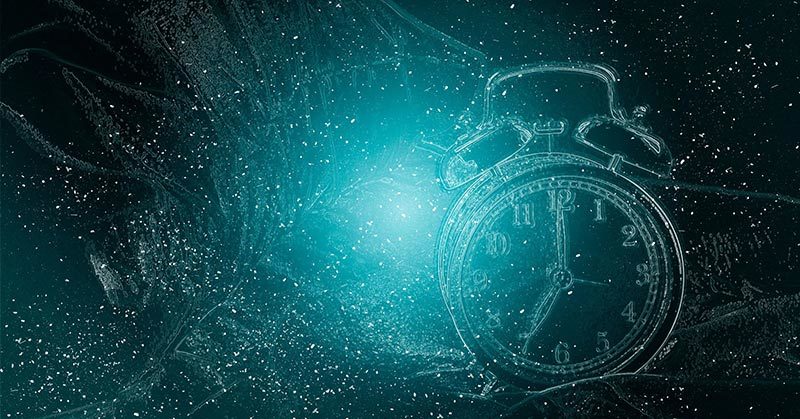Sometimes, the line between science and science fiction seems to blur. Like when scientists discovered a mirror universe, or created an invisibility shield. A few years ago, researchers blurred that line again when they created time crystals.
As if that doesn’t sound enough like a prop from a sci-fi film, they didn’t stop there. Recently, physicists witnessed time crystals interacting for the first time ever. This new discovery could have major implications for quantum computing, atomic clocks, and GPS [1].
What are Time Crystals?
A time crystal is a new phase of matter. To understand exactly what it is, first let’s look at a regular crystal.
A regular crystal is made up of atoms that are arranged in a pattern. This pattern repeats itself across physical space, creating a lattice structure. This structure extends out in three dimensions, and because it repeats itself, crystals have recognizable structures.
These periodic repetitions are what give large crystals their flat faces and well-defined angles. These are called euhedral crystals. Crystals without flat faces are anhedral. When a crystal consists of orderly arrays of atoms that are not periodic, we call this a quasicrystal [2].
Time crystals differ from regular crystals because instead of repeating their patterns across physical space, they repeat them through time instead. Scientists first proposed the possibility of their existence in 2012, but many believed that the laws of thermal equilibrium made them impossible.
Read: Quantum Glass Battery Will Change The World
Non-Equilibrium Matter
The laws of thermal equilibrium state that in most matter, hotter atoms will transfer heat to cooler atoms next to them. They will continue to do this until they reach the same temperature. Once they reach that point, they settle into a state we refer to as thermal equilibrium.
Time crystals, however, never reach that state. Instead, they repeat the pattern of movement over time in what appears to be a type of perpetual motion. This makes them perhaps the first example of non-equilibrium phases, a new type of matter [3].
To explain just how strange time crystals are, Norma Yao of UC Berkeley uses Jell-o as an example. When you tap on a bowl of Jell-o, you expect it to jiggle right away, then gradually settle down until it stops moving. The jiggling will only start again if you tap the bowl again.
In the case of time crystals, however, you might tap the bowl but there would be a delay before it jiggles. Then, the Jell-O would start to jiggle again at regular intervals without you tapping the bowl at all. Essentially, this class of new materials is unable to settle down into motionless equilibrium.
“This is a new phase of matter, period, but it is also really cool because it is one of the first examples of non-equilibrium matter,” Yao said. “For the last half-century, we have been exploring equilibrium matter, like metals and insulators. We are just now starting to explore a whole new landscape of non-equilibrium matter.” [4]
Scientists Catch Time Crystals Interacting
For the first time ever, scientists have observed two time crystals interacting. The researchers who made the observation are from Yale, Lancaster, and Aalto Universities, as well as Royal Holloway London.
The team cooled a superfluid for of helium-3 down to just above absolute zero. That is a temperature of -273.15 degrees Celsius, or -459.67 degrees Fahrenheit. Next, they created two-time crystals in the superfluid and let them touch.
The two crystals passed particles back and forth, putting their motions into an alternating pattern. Samuli Autti, the lead author of the study, says that controlling the interaction of two these crystals is a major achievement.
“Before this, nobody had observed two time crystals in the same system, let alone seen them interact,” Autti explained. “Controlled interactions are the number one item on the wish list of anyone looking to harness a time crystal for practical applications, such as quantum information processing.” [1]
What Does This Mean for the Future?
Before this new research, there was no way that scientists knew of that would allow for time crystals to be a part of a designed system. The fact that the moving particles within these crystals continue to move and never lose energy seems to defy the laws of physics.
This begs the question, where is the initial energy coming from, and why doesn’t it ever seem to dissipate? [5]
Despite the unknowns, this new research could be the first step toward using these crystals in practical applications like quantum computers.
The main problem that we have with quantum computers is that the information has trouble staying stable for long periods of time. Time crystals appear to do this quite easily, so they could potentially help scientists overcome some of those problems. This could also lead to advancements in other technologies, such as atomic clocks and the systems that rely on them, like GPS.
The researchers made the following statement in their study:
“Our results demonstrate that time crystals obey the general dynamics of quantum mechanics and offer a basis to further investigate the fundamental properties of these phases, opening pathways for possible applications in developing fields, such as quantum information processing.” [6]
- https://newatlas.com/physics/time-crystals-interacting-first-time/
- https://www.thoughtco.com/what-is-a-crystal-607656
- https://newatlas.com/time-crystals-created-new-form-matter/48347/?itm_source=newatlas&itm_medium=article-body
- https://news.berkeley.edu/2017/01/26/scientists-unveil-new-form-of-matter-time-crystals/
- https://www.popularmechanics.com/science/a33648414/scientists-catch-time-crystals-interacting/
- https://www.nature.com/articles/s41563-020-0780-y

